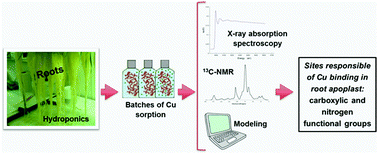Involvement of nitrogen functional groups in high-affinity copper binding in tomato and wheat root apoplasts: spectroscopic and thermodynamic evidence†
Abstract
Carboxylic groups located in plant cell walls (CW) are generally considered to be the main copper binding sites in plant roots, despite the presence of other functional groups. The aim of this study was to investigate sites responsible for copper binding in root apoplasts, i.e. CW and outer surface of the plasma membrane (PM) continuum. Binding sites in root apoplasts were investigated by comparing isolated CW of a monocotyledon (Triticum aestivum L.) and dicotyledon (Solanum lycopersicum L.) crop with their respective whole roots. Copper speciation was examined by X-ray absorption (XAS) and 13C-nuclear magnetic resonance spectroscopies while the affinity of ligands involved in copper binding was investigated by modeling copper sorption isotherms. Homogeneous speciation and binding of copper was found in wheat and tomato root apoplasts. Only Cu–N and Cu–O bonds were detected in wheat and tomato root apoplasts. Nitrogen/oxygen ligands were identified in slightly higher proportions (40–70%) than single oxygen ligands. Furthermore, low- and high-affinity binding sites contributed in an almost equivalent proportion to copper binding in root apoplasts. The high-affinity N functional groups embedded in root apoplasts participated in copper binding in the same magnitude than the low-affinity carboxylic groups.


 Please wait while we load your content...
Please wait while we load your content...